RBH MC Series Package 5 Home Theater Loudspeaker System
by Colin Miller
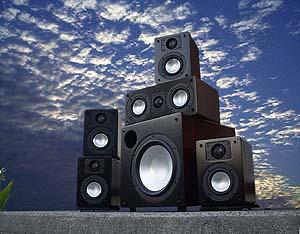 Metal-coned
drivers used to be the sole domain of the very expensive loudspeakers
lines. Let's face it, there's something exotic about a metal cone, when
poly and paper cones dominate the market. No less the impressionable, I
was delighted when RBH sent us an affordable package of home theater
speakers where all drivers, including the subwoofer, have metal cones.
And, for the spouses, the finish is a veneer veneer.
Metal-coned
drivers used to be the sole domain of the very expensive loudspeakers
lines. Let's face it, there's something exotic about a metal cone, when
poly and paper cones dominate the market. No less the impressionable, I
was delighted when RBH sent us an affordable package of home theater
speakers where all drivers, including the subwoofer, have metal cones.
And, for the spouses, the finish is a veneer veneer.
Metal drivers do have a great advantage over drivers made with many other materials in that they are extremely stiff, However, they can also be difficult to work with, and even manufacture. One reason that metal cones generally cost so much is that they may crack during the manufacturing process. The fact that RBH can offer a reasonably priced system using exclusively metal drivers says that somebody';s been doing something about the problems in the factory.
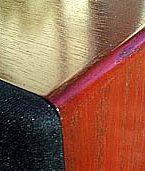 The
inherent stiffness of metal doesn';t mean that they don';t bend at all,
but rather that they won';t start to resonate until driven at a
substantially higher frequency than equivalent plastic or paper
counterparts, much as a guitar string will resonate at a higher
frequency if tightened. This feature allows a higher upper-end bandwidth
limit for a given driver size, below which the driver operates in a
pistonic fashion, essentially eliminating diaphragm break-up below that
frequency. It doesn't absolutely guarantee low distortion, as the motor
assembly/suspension also has an effect, but it certainly helps. I must
stress that this is only IF the driver can be limited to operate
exclusively within that pistonic range, a very real advantage.
The
inherent stiffness of metal doesn';t mean that they don';t bend at all,
but rather that they won';t start to resonate until driven at a
substantially higher frequency than equivalent plastic or paper
counterparts, much as a guitar string will resonate at a higher
frequency if tightened. This feature allows a higher upper-end bandwidth
limit for a given driver size, below which the driver operates in a
pistonic fashion, essentially eliminating diaphragm break-up below that
frequency. It doesn't absolutely guarantee low distortion, as the motor
assembly/suspension also has an effect, but it certainly helps. I must
stress that this is only IF the driver can be limited to operate
exclusively within that pistonic range, a very real advantage.
That';s not to say that drivers which flex intentionally in order to produce a more gradual and controlled upper-end roll off (and coincidentally more even high frequency dispersion) have inferior capabilities, or necessarily distort more, but rather that very stiff cones, by extending the upper-end limit and pistonic range, can lower distortion by attempting to avoid a flexing cone as opposed to controlling the flexure. Simply a different means to an end. And, like every means, there are certain issues that the designer must address in order to create a good end product.
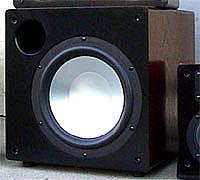 Although
metal is very stiff, as mentioned, the damping properties usually leave
a bit to be desired. The stiffness will put off diaphragm resonance
until a higher frequency, but if allowed to operate in or near that
breakup range, the driver will ring (the cone is shaped like a metal
bell), resulting in a time smear as well as an amplitude peak that may
prove quite irritating. One can add damping material on top of the metal
and reduce that problem, but possibly eliciting another.The added mass
of the damping material then decreases efficiency, lowers suspension
damping, and may perhaps even cause greater flexure of the metal cone
due to the increased load. Plus, it will substantially increase the
manufacturing cost of the drivers.
Although
metal is very stiff, as mentioned, the damping properties usually leave
a bit to be desired. The stiffness will put off diaphragm resonance
until a higher frequency, but if allowed to operate in or near that
breakup range, the driver will ring (the cone is shaped like a metal
bell), resulting in a time smear as well as an amplitude peak that may
prove quite irritating. One can add damping material on top of the metal
and reduce that problem, but possibly eliciting another.The added mass
of the damping material then decreases efficiency, lowers suspension
damping, and may perhaps even cause greater flexure of the metal cone
due to the increased load. Plus, it will substantially increase the
manufacturing cost of the drivers.
Another possibility is to limit operation in the breakup region by means of the crossover. By either placing the crossover point far below the diaphragm resonance, and/or using a steep crossover slope, any signal that could excite the resonance is severely attenuated, as is the response peak that would otherwise dominate the output. The RBH speakers took the route of appropriate crossover implementation, both with the satellites, and with the subwoofer (shown at left, above).
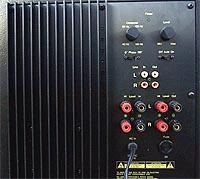 >In
addition to the variable low-pass filter (40 Hz -180 Hz), the back
panel of the sub (shown below, right) sports a volume control, line
level inputs, line level loop outs, speaker level inputs, speaker level
100 Hz high-pass loop outputs, a phase reversal switch, and an Auto On
switch. Enough to keep the tinkerer happy, as well as provide the tools
for a successful setup at home.
>In
addition to the variable low-pass filter (40 Hz -180 Hz), the back
panel of the sub (shown below, right) sports a volume control, line
level inputs, line level loop outs, speaker level inputs, speaker level
100 Hz high-pass loop outputs, a phase reversal switch, and an Auto On
switch. Enough to keep the tinkerer happy, as well as provide the tools
for a successful setup at home.
Anyway, even though a 15" woofer will hit its diaphragm resonance at a lower frequency than say a 6" woofer with the same material stiffness, any decent sub will work within its pistonic range under 100 Hz, even perhaps 200 Hz. With a 10" driver and a metal cone, the RBH TS-10-A achieves this criteria by a safe margin, avoiding any unpleasant output due to cone breakup.
However, that in itself doesn't guarantee good pudding, probably why RBH didn't stop there. The cabinet must also not resonate near the operating range of the subwoofer, and/or have enough damping to avoid coloration. Again, not a problem. The TS-10-A sub responded to knuckle raps with an enthusiastic click, implying no worries in this department.
For subwoofers, the most common source of harmonic distortion arises within the motor structure, exacerbated by the high excursions that deep bass requires. With a 10 " driver, even a long-throw unit as such used in the TS-10-A, the displacement requirements of low frequency reproduction would be quite extreme with a simple sealed system. RBH chose to use a bass-reflex design, loading the woofer acoustically with the port, minimizing cone excursion at and above the tuned frequency (most likely near the 30 Hz specified cutoff point), thereby lowering distortion generated by any possible non-linearty in the motor (like operating outside of the voice coil gap!)
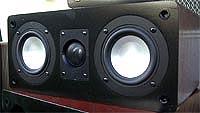 As
with any design choice, there are compromises in a bass-reflex system,
such as a slightly degraded transient response at the lower cut-off,
minor port non-linearity at high output levels, possible turbulence, and
almost no useable output just below the ported frequency, all of which
can contribute to a sound characteristic of ported designs. Even within
these limitations, RBH achieved what they set out to do, and their unit
sounds at least as good as the competition along those parameters,
perhaps better than many. I didn';t notice any obvious chuffing or pipe
resonance from the port, and the output was clean, deep, and downright
intimidating at times, reminding me a little of the much more expensive
REL subs that also sport the port, so to speak.
As
with any design choice, there are compromises in a bass-reflex system,
such as a slightly degraded transient response at the lower cut-off,
minor port non-linearity at high output levels, possible turbulence, and
almost no useable output just below the ported frequency, all of which
can contribute to a sound characteristic of ported designs. Even within
these limitations, RBH achieved what they set out to do, and their unit
sounds at least as good as the competition along those parameters,
perhaps better than many. I didn';t notice any obvious chuffing or pipe
resonance from the port, and the output was clean, deep, and downright
intimidating at times, reminding me a little of the much more expensive
REL subs that also sport the port, so to speak.
The 30 Hz cutoff point, combined with the sharp roll-off inherent with bass reflex designs, doesn't allow the ultra-low in-room response that can unsettle a foundation, but for theatrical material, and most musical selections, the low-end gut-thumping pump proved satisfying indeed. I';d daresay it';d impress the in-laws, or perhaps even scare them away }:>) Reality check, this is an entire system of metal coned speakers for less than $2,000. Just a few years ago, such a system would have been much more expensive, and the woofer would not have had a metal cone.
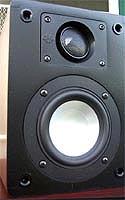 The
MC-4 satellite speakers (left), as well as the MC-414 center channel
(below, right) also have their own clever aspects. In the case of the 4"
metal mid-bass drivers, a smaller cone might be better than a larger
cone, at least in terms of the upper mid-range response. Again, like a
guitar string pinched to the neck, a smaller diaphragm will resonate at a
higher frequency than a larger one of the same material stiffness. It's
not unheard of for 4" drivers to operate in almost a full-range
fashion, pushing their breakup region beyond 8 kHz or so. Combine that
with a crossover at roughly 3 kHz (12dB/octave electrically, sharper
after driver response), and you've got an easy transition, avoiding the
possibly nasty breakup of the mid-bass driver . One could argue, I
suppose, that the tweeter will see its breakup range. On the other hand,
one could also argue that we won';t see diaphragm resonance until
beyond 20 kHz, and that harmonic distortion resulting from that breakup
won't appear until over 40 kHz!
The
MC-4 satellite speakers (left), as well as the MC-414 center channel
(below, right) also have their own clever aspects. In the case of the 4"
metal mid-bass drivers, a smaller cone might be better than a larger
cone, at least in terms of the upper mid-range response. Again, like a
guitar string pinched to the neck, a smaller diaphragm will resonate at a
higher frequency than a larger one of the same material stiffness. It's
not unheard of for 4" drivers to operate in almost a full-range
fashion, pushing their breakup region beyond 8 kHz or so. Combine that
with a crossover at roughly 3 kHz (12dB/octave electrically, sharper
after driver response), and you've got an easy transition, avoiding the
possibly nasty breakup of the mid-bass driver . One could argue, I
suppose, that the tweeter will see its breakup range. On the other hand,
one could also argue that we won';t see diaphragm resonance until
beyond 20 kHz, and that harmonic distortion resulting from that breakup
won't appear until over 40 kHz!
On the bass side of things, getting 70 Hz from 4" cones in a very small, sealed enclosure is tricky. At first, I thought that they might be pulling my leg, or perhaps both of them. But, after measuring the drivers, the claim seemed entirely plausible, and listening verified the measurements. Their standalone bass is not impressive by itself, but it can hold its own until the subwoofer can drop in to back up. Of course, that';s why using subwoofers with bookshelf-style speakers became so popular in the first place. The sacrifice for even moderate bass extension in a small, sealed cabinet, of course, is efficiency. While porting the satellites would have allowed a more efficient design, or even deeper extension at the same efficiency, the satellites' sealed enclosures arguably make the blend with a subwoofer that much easier. Considering that they were put together as a system, not as stand alone mini-monitors, that makes sense.
Like many speakers, the specified voltage sensitivity is quite optimistic for both the MC-4-C and the MC-414-C, more so with the MC-4-C. Based on measuring the moving mass, motor characteristics, and diaphragm surface area, the voltage sensitivity is a few dB down from the published 87 dB/2.83 volts/meter (MC-4-C) and 91 dB/2.83 volts/meter MC-414-C). That';s really not bad at all. The majority of loudspeaker manufacturers exaggerate the numbers (a la marketing pressure) on either frequency response or efficiency. I've seen some models that actually turned out 6 dB below the published voltage sensitivity spec. Middle 80s on voltage sensitivity is moderately sensitive in the real world, and with an easy impedance, it';s actually pretty good.
The center channel uses two drivers in a classic symmetrical MTM arrangement (Mid — Tweeter — Mid). While a horizontal MTM configuration will exhibit off-axis horizontal lobing in the upper midrange, the small physical size of and distance between the drivers kept it reasonable. Although the sound loses a bit on consistency as you move sideways, I never found it bothersome. As a plus, the use of two drivers wired in parallel bumps the potential voltage sensitivity up 6 dB (twice the power draw and handling at the given input voltage, coupled with a two-fold efficiency increase.)
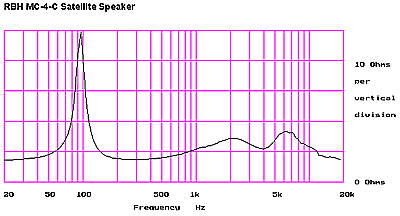
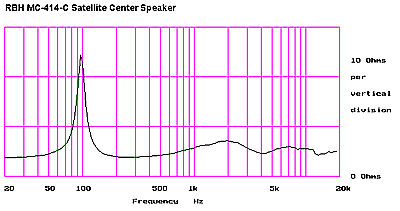
I think it important to stress that while the little MC-4-Cs don't spec out all that high in terms of voltage sensitivity, that's not to say that they're truly inefficient, but rather, that they simply need some voltage swing to get going. Most amplifiers, even receivers, have plenty of voltage for regular listening levels. Where most amplifiers fall short, especially amplifiers found in mass market products, is on current delivery, which in turn wreaks havoc on their voltage signal. It seems, almost, like a catch 22. A look at the impedance chart of the MC-4-C shows a relatively benign impedance. The specified nominal 8 Ohms sits closer to 11 Ohms, with a large 50 Ohm peak at woofer resonance. (Although a few of my friends think that a demanding impedance is the sign of a good loudspeaker, as it tends to reveal, or perhaps rather create, substantial differences in amplifiers, I think that an easy load is a very desirable trait, all else being equal.)
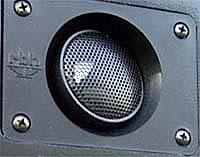 While
the MC-414 has a much higher voltage sensitivity, the impedance also
drops much lower, almost exactly half. It's not a killer load, but could
conceivably cause problems with cheap receivers and poor excuses for
outboard amps. Even though it does drop to 4 Ohms along much of its
working range, with a maximum of 24 Ohms at woofer resonance, the
nominal load sits somewhere around 5 or 6 Ohms. That's really pretty
good and fortunately, is only characteristic of the center channel
(albeit the most important speaker for 5.1), so that most good receivers
should be able to handle its more current hungry personality without
coughing up blood.
While
the MC-414 has a much higher voltage sensitivity, the impedance also
drops much lower, almost exactly half. It's not a killer load, but could
conceivably cause problems with cheap receivers and poor excuses for
outboard amps. Even though it does drop to 4 Ohms along much of its
working range, with a maximum of 24 Ohms at woofer resonance, the
nominal load sits somewhere around 5 or 6 Ohms. That's really pretty
good and fortunately, is only characteristic of the center channel
(albeit the most important speaker for 5.1), so that most good receivers
should be able to handle its more current hungry personality without
coughing up blood.
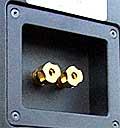 Other
features of both the '4 and '414 that require mention include tweeters
you can aim. While it isn't academically ideal from a diffraction
standpoint to mount tweeters on a non-flush surface, it does allow less
than optimal placement, such as above or below the listening position on
shelves, to yield more optimal results. For most consumers, that can be
of great practical advantage. Did I mention they're pretty? Even
without the fancy binding posts, the MC Series Package 5 is hands down
the most attractive 5.1 system I've come across under $3,000, maybe
more. It's not often that you see such a nice finish or build quality in
speakers with such a low price tag.Our review samples, finished in a
nice deep red cherry, looked like furniture.
Other
features of both the '4 and '414 that require mention include tweeters
you can aim. While it isn't academically ideal from a diffraction
standpoint to mount tweeters on a non-flush surface, it does allow less
than optimal placement, such as above or below the listening position on
shelves, to yield more optimal results. For most consumers, that can be
of great practical advantage. Did I mention they're pretty? Even
without the fancy binding posts, the MC Series Package 5 is hands down
the most attractive 5.1 system I've come across under $3,000, maybe
more. It's not often that you see such a nice finish or build quality in
speakers with such a low price tag.Our review samples, finished in a
nice deep red cherry, looked like furniture.
And what does all this self-serving jargon boil down to? A pot full of Gumbo Louis!
Overall, I enjoyed listening to the MC Series Package 5 almost as much as I adored staring at it. The system delivered a sweet, slightly peppered, but never harsh rendition of whatever the amplifier served up. Altogether light in countenance, but with an affinity for an occasional nip, the speakers engaged movie dialogue with a passion, accents of sibilants easy to distinguish, but not painful to the ears. Clarity was great, sometimes perhaps a little overly brilliant, but not distastefully so. I thought many times to myself, "Illuminating."
The Package 5 system always put forth a nice impression. Not surprisingly, though, the sound of the satellites did vary a bit depending on the amplifier used, especially with the center channel. Since the subwoofer already has a 160 watt amplifier built-in, there's no question on matching. The 10" metal sub and its big bass-reflex tube carried no deficiencies in pugilistic might. While it did leave out the very lowest half octave (what 5.1 system at this price doesn't?), it threw down gusto and pizzaz, like a baseball bat in the ribs, except without the hospital visit.
With the MC-4-C and MC-414-C, my Aragon amps provided the greatest clarity of the bunch, but brought out a little bite in the tweeters. The Yamaha RX-V995 by itself actually sounded the smoothest, though perhaps too soft, sacrificing raw detail, depth, and finesse. The Sunfire's easy-going "Voltage Output" won out as the most enjoyable for me when matched with the Package 5. Just like apple cider- a tad of sparkle with a sweet and mellow body to boot, suggesting perhaps something like a Sunfire Cinema Grand to keep 'em warm. A Cinema Grand Signature would be slightly pricey in proportion to the cost of the speakers, but I don't think either unrealistic or a waste of resources. Even if a good dedicated amplifier isn't an option, better receivers should still do rather well by themselves. As always, try, then decide.
Given that a person can walk into a retailer and pay full boat for a complete 5.1 loudspeaker setup with metal cones, I must say, "Well Done." I'd even throw in a "Stupendous" if that's worth anything these days. When integrated carefully, the RBH MC-Series Package 5 could just sneak up on the jaded veteran and starting enthusiast alike. Surprise! Guess what, I'm left smiling.
RBH MC Series Package 5 Loudspeaker System.
MC-4 Front/Rear Speakers, MC-414-C Center Speaker, and TS-10-A 10" Powered Subwoofer
RBH MC Series Package 5 Loudspeaker System.
Front/Rear Speakers, MC-414-C Center Speaker, and TS-10-A 10" Powered Subwoofer
Dimensions; MC-4C, 9" H x 6 1/2" W x 7" D 7 1/2 lbs. MC-414C 6 1/2" H x 14 1/2" W 9 1/2" D 13 lbs. TS-10A 14 3/4" H 14" W 16 1/2" D.
Power Handling; MC-4C 100 watts, MC-414C 150 watts TS-10A internal amplifier rated at 160 watts FR; MC-4C & MC-414C 70-20,000 Hz +/- 3dB TS-10A 30-180 Hz.
MSRP: In standard black veneer veneer: $1,499.00. With all six pieces in either cherry veneer veneer or in white semi-gloss finish: $1,725.00.
For the Record, components used during review:
Aragon 8008BB Stereo Power Amplifier
Aragon 8008x3 Three-Channel Power Amplifier
Sunfire Stereo Power Amplifier
Yamaha RX-V995 Receiver
Infinity Renaissance 90 Loudspeakers
M&K THX Select Loudspeaker System
M&K S-1C Monitors & MX-700 subwoofer
JVC XL-Z1050 CD player
Toshiba 2109 DVD Player
Bybee/Curl Prototype AC Purifiers & Power Cords
M'Dor Power Cord
DH Labs Silver Sonic Interconnects
AudioQuest Diamond Interconnects
Liberty Emerald 14-4 Speaker cable, custom-terminated.
© Copyright 1999 Secrets of Home Theater & High Fidelity